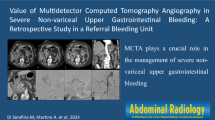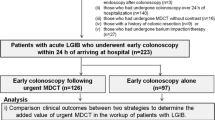Abstract
Purpose
To evaluate the utility of dual energy CT angiography (DECTA) in acute non-variceal gastrointestinal hemorrhage (ANVGIH) compared to digital subtraction angiography (DSA) as gold standard.
Materials and methods
111 Patients (mean age: 39.2 years; 94 males) of ANVGIH who underwent both DECTA and DSA between January 2016 and September 2021 were included. Virtual monochromatic (VM) images at 10 keV increments from 40 to 70 keV and blended (120kVp equivalent) images of arterial phase of DECTA were evaluated independently by two readers blinded to DSA information. Quantitative analysis included measurement of attenuation in the major arteries (abdominal aorta, celiac artery, superior mesenteric artery), suspected vascular lesion, and lesion feeding artery to calculate contrast-to-noise ratios (CNRs) and signal-to-noise ratios (SNRs). Qualitative analysis assessed the image quality of each data set using a 3-point Likert scale. Findings on DSA were evaluated by a third reader and both DECTA and DSA were compared.
Results
On linear blended images, vascular lesion was identified by reader 1 in 88 (79.3%) and by reader 2 in 87 (78.4%) patients and DSA showed lesion in 92 (82.9%) patients. The sensitivity and specificity of blended images and VM images of DECTA for lesion detection were not significantly different from each other. The CNR and SNR of arteries, vascular lesion and feeding artery were significantly higher at 70 keV (p < 0.005) compared to blended and other VM images. Although subjective scores for image quality were higher for 60 keV images by both readers, the difference was not statistically significant (p = 0.3). The interobserver agreement was mostly good.
Conclusion
In the assessment of ANVGIH, the 60 keV and 70 keV VM images improved the image quality and contrast, respectively, but there was no increase in diagnostic accuracy of VM image datasets compared to linearly blended images. Hence, the diagnostic utility of DECTA in ANVGIH is still uncertain.
Graphical abstract





Similar content being viewed by others
References
Mujtaba S, Chawla S, Massaad JF (2020). Diagnosis and Management of Non-Variceal Gastrointestinal Hemorrhage: A Review of Current Guidelines and Future Perspectives. J Clin Med. 9:402.
Barkun AN, Almadi M, Kuipers EJ, et al (2019). Management of Nonvariceal Upper Gastrointestinal Bleeding: Guideline Recommendations From the International Consensus Group. Ann Intern Med. 171:805–22.
Carney BW, Khatri G, Shenoy-Bhangle AS (2019). The role of imaging in gastrointestinal bleed. Cardiovasc Diagn Ther. 9:S88–96.
Wu LM, Xu JR, Yin Y, Qu XH (2010). Usefulness of CT angiography in diagnosing acute gastrointestinal bleeding: A meta-analysis. World J Gastroenterol. 16:3957–63.
García-Blázquez V, Vicente-Bártulos A, Olavarria-Delgado A, et al (2013). Accuracy of CT angiography in the diagnosis of acute gastrointestinal bleeding: systematic review and meta-analysis. Eur Radiol. 23:1181–90.
Liu PS, Platt JF (2014). CT angiography in the abdomen: a pictorial review and update. Abdom Imaging. 39:196–214.
Laing CJ, Tobias T, Rosenblum DI, Banker WL, Tseng L, Tamarkin SW (2007). Acute gastrointestinal bleeding: emerging role of multidetector CT angiography and review of current imaging techniques. Radiographics. 27:1055–70.
Wortman JR, Landman W, Fulwadhva UP, Viscomi SG, Sodickson AD (2017). CT angiography for acute gastrointestinal bleeding: what the radiologist needs to know. Br J Radiol. 90:20170076.
Coursey CA, Nelson RC, Boll DT, et al (2010). Dual-Energy Multidetector CT: How Does It Work, What Can It Tell Us, and When Can We Use It in Abdominopelvic Imaging? RadioGraphics. 30:1037–55.
Jia X, Li X, Li J, et al (2020). Improving diagnostic accuracy for arteries of lower extremities with dual-energy spectral CT imaging. Eur J Radiol. 128:109061.
Martin SS, Wichmann JL, Scholtz JE, et al (2017). Noise-Optimized Virtual Monoenergetic Dual-Energy CT Improves Diagnostic Accuracy for the Detection of Active Arterial Bleeding of the Abdomen. J Vasc Interv Radiol. 28:1257–66.
Mohammadinejad P, Kwapisz L, Fidler JL, et al (2021). The utility of a dual-phase, dual-energy CT protocol in patients presenting with overt gastrointestinal bleeding. Acta Radiol Open. 10:20584601211030656.
Mileto A, Ananthakrishnan L, Morgan DE, Yeh BM, Marin D, Kambadakone AR (2021). Clinical Implementation of Dual-Energy CT for Gastrointestinal Imaging. AJR Am J Roentgenol. 217:651–63.
Cui Y, Gao SY, Wang ZL, et al (2012). Which should be the routine cross-sectional reconstruction mode in spectral CT imaging: monochromatic or polychromatic? Br J Radiol. 85:e887–90.
Lennartz S, Große Hokamp N, Zäske C, et al (2020). Virtual monoenergetic images preserve diagnostic assessability in contrast media reduced abdominal spectral detector CT. Br J Radiol. 93:20200340.
Yu L, Leng S, McCollough CH (2012). Dual-energy CT-based monochromatic imaging. AJR Am J Roentgenol. 199:S9–15.
Sun H, Hou XY, Xue HD, et al (2015). Dual-source dual-energy CT angiography with virtual non-enhanced images and iodine map for active gastrointestinal bleeding: image quality, radiation dose and diagnostic performance. Eur J Radiol. 84:884–91.
Mongan J, Rathnayake S, Fu Y, Gao DW, Yeh BM (2013). Extravasated Contrast Material in Penetrating Abdominopelvic Trauma: Dual-Contrast Dual-Energy CT for Improved Diagnosis—Preliminary Results in an Animal Model. Radiology. 268:738–42.
Shaqdan KW, Parakh A, Kambadakone AR, Sahani DV (2019). Role of dual energy CT to improve diagnosis of non-traumatic abdominal vascular emergencies. Abdom Radiol (NY). 44:406–21.
Machida H, Tanaka I, Fukui R, et al (2016). Dual-Energy Spectral CT: Various Clinical Vascular Applications. Radiographics. 36:1215–32.
Matsumoto K, Jinzaki M, Tanami Y, Ueno A, Yamada M, Kuribayashi S (2011). Virtual monochromatic spectral imaging with fast kilovoltage switching: improved image quality as compared with that obtained with conventional 120-kVp CT. Radiology. 259:257–62.
Zhang D, Li X, Liu B (2011). Objective characterization of GE discovery CT750 HD scanner: gemstone spectral imaging mode. Med Phys. 38:1178–88.
He J, Ma X, Wang Q, Fan J, Sun Z (2014). Spectral CT demonstration of the superior mesenteric artery: comparison of monochromatic and polychromatic imaging. Acad Radiol. 21:364–8.
Funding
None.
Author information
Authors and Affiliations
Corresponding author
Ethics declarations
Conflict of interest
The authors declare that they have no conflict of interest.
Additional information
Publisher's Note
Springer Nature remains neutral with regard to jurisdictional claims in published maps and institutional affiliations.
Rights and permissions
Springer Nature or its licensor (e.g. a society or other partner) holds exclusive rights to this article under a publishing agreement with the author(s) or other rightsholder(s); author self-archiving of the accepted manuscript version of this article is solely governed by the terms of such publishing agreement and applicable law.
About this article
Cite this article
Agarwal, A., Kumar, K.P. & Madhusudhan, K.S. Utility of dual energy CT angiography in the evaluation of acute non-variceal gastrointestinal hemorrhage: comparison with digital subtraction angiography. Abdom Radiol 48, 1880–1890 (2023). https://doi.org/10.1007/s00261-023-03864-7
Received:
Revised:
Accepted:
Published:
Issue Date:
DOI: https://doi.org/10.1007/s00261-023-03864-7




